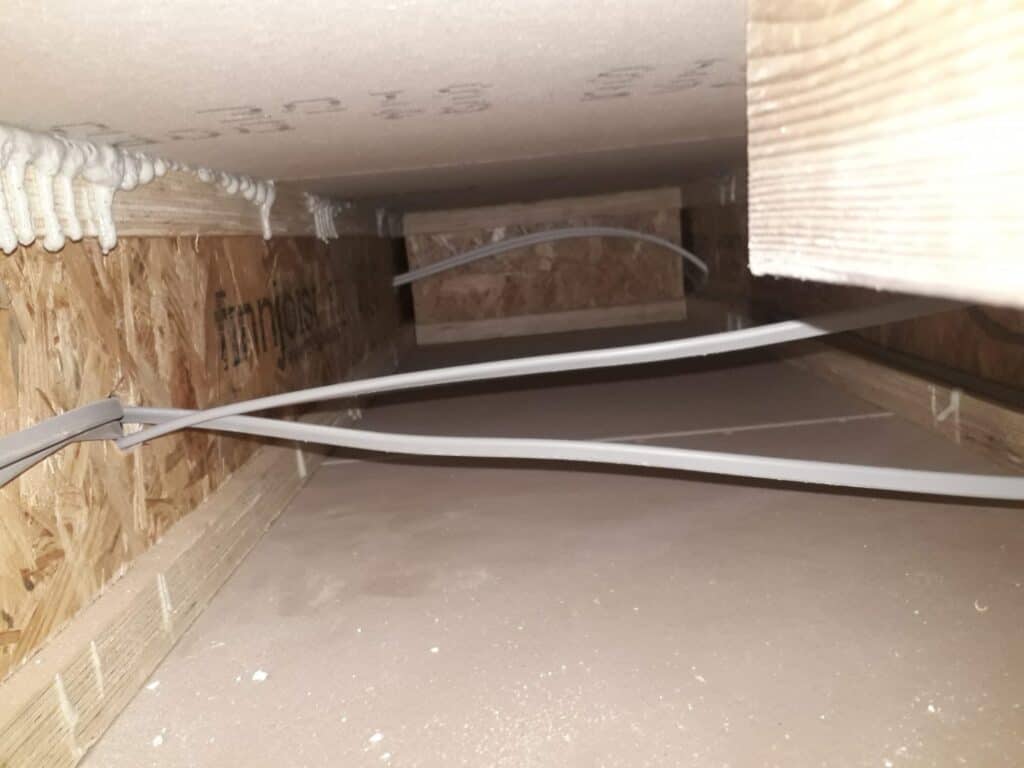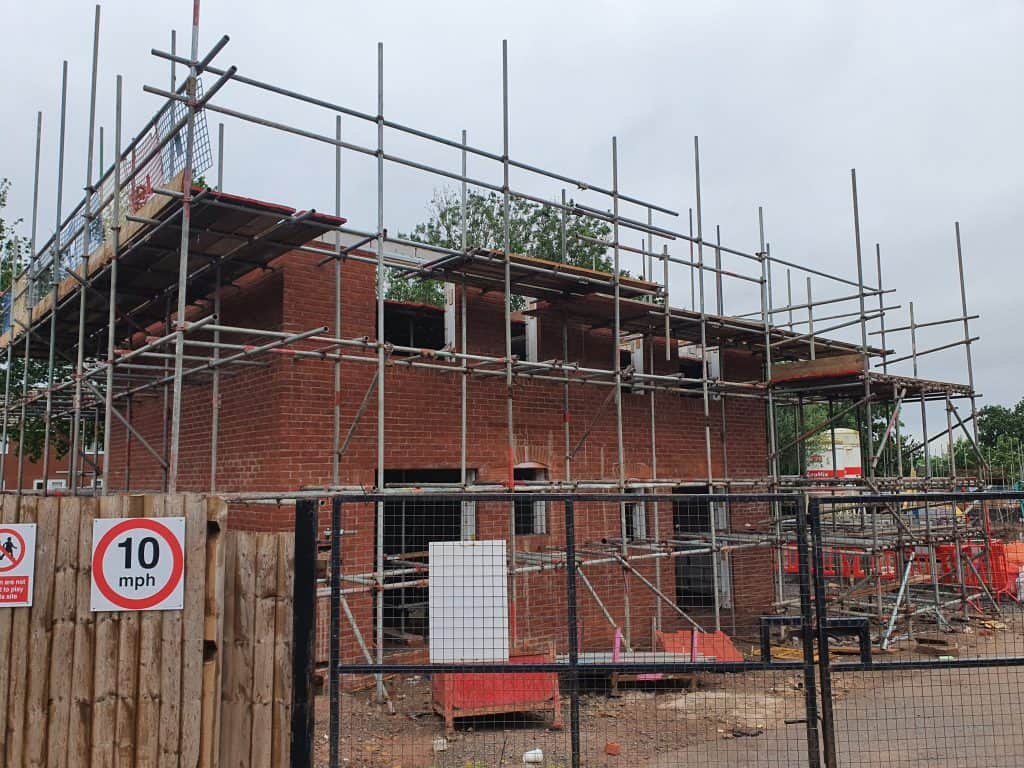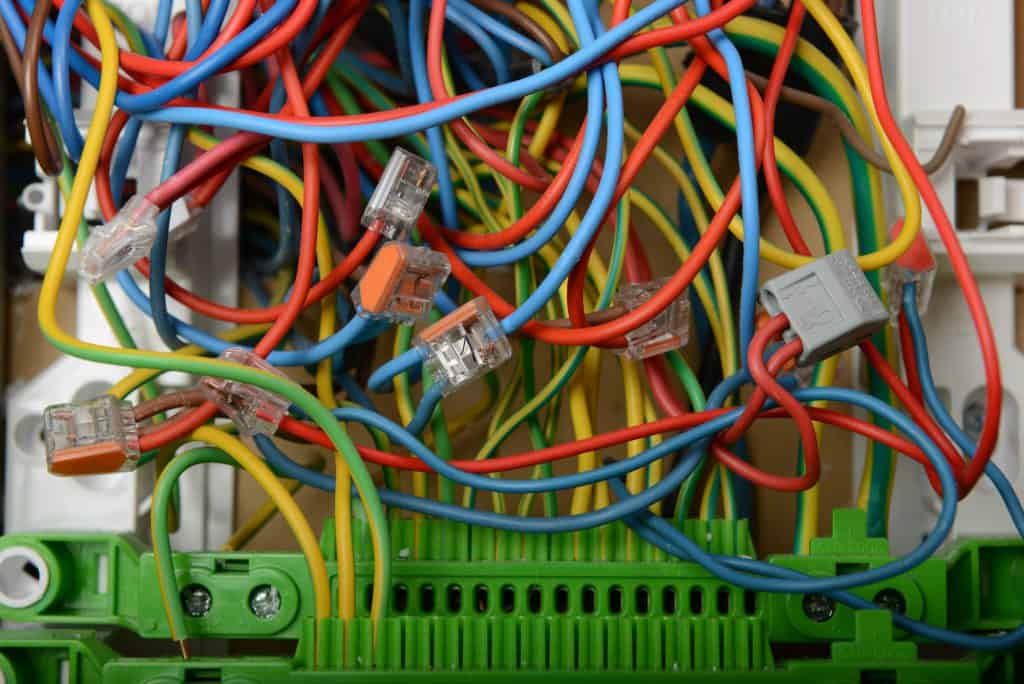“Just run the cable along the joists.” I’ve heard this said many times. Everyone from DIYers to professional electricians looks for the quickest and easiest ways to finish a job safely, so when it comes to running wires in a ceiling, the joists are often the quickest and most natural places to do so. But is this a good idea, and if it is, what is the best way to run wires along (or through) ceiling joists?
The best way to run wires along ceiling joists is to use a running board, spacing the wires evenly with electrical staples. This is for running wires in the direction of the joists or perpendicular to them. If there is no space, you can bore holes in very specific places to run wires through.
Using the existing structure of ceiling joists makes sense to run wires, they already run from one wall to the opposite wall and are evenly spaced. But there are a few must-know details to keep your ceiling wires safe, neat, and working for years to come. Let’s nail some of these down!
What Are Ceiling Joists?

Ceiling Joists are the horizontal timber beams that provide structure under the roof trusses to fix the ceiling to. Often these joists play an additional role of supporting and fixing diagonal rafters that give shape to the roof.
Modern roof constructions often have factory-manufactured roof trusses that use the bottom timber of the truss as the joist. The ceiling sheets are often attached directly to these, but thinner strips of wood may also be used between the joist and the ceiling sheet.
For a handy image of all the names for the different parts of a ceiling, have a look at this link
The Best Way To Secure Wires To A Joist
The ideal time to run wiring is naturally during the initial construction, when the ceiling cavities, joists and battens are still open.

Pulling wire, stapling and positioning are easiest when everything is open to view and accessible. Unfortunately, there will come a time when you need to run electrical wiring for lights and other electrical appliances after the fact.
By far the best way to secure one or many wires to a joist is to use a running board if space in the attic or ceiling cavity will allow it. A running board is a length of timber that wires are stapled to that is laid on top of the joists.
This is true for running wires in the same direction as the joists or running wires perpendicular to the joists. Think of it like an athletics track, neatly laid out rows of wires all running to the finish line together, but without interfering with another wire’s race!
There are two good reasons to use a running board:
- First, the running board will only need to be attached to the joists in two or three places rather than sinking nails into every joist. Running boards can be moved or removed with minimal damage to the joists themselves.
- Second, if the space allows it, the wires can be attached neatly to the running board outside of the ceiling space with the additional wire to be run down the walls neatly rolled on the sides and the whole running board can be slotted into the ceiling without having to work in the small space of the ceiling.
If there is no space in the attic or ceiling cavity to use a running board, then running electrical wires through the channel between ceiling joists is generally easiest. In this case, fixing the wire directly to the joist is best, don’t just lay the wire in the cavity. Use an adequate number of staples and aim for the wire to be taut but not stretched or sagging, giveing it just the right amount of tension.
If there is no space above or below the joists and you need to run the wires perpendicular to the joists an option is to run wires through the joists by drilling holes and feeding the wire through.
When And How To Drill Holes In Joists
Drilling holes in joists should be the last option when it comes to running wires in a ceiling. If there is a way to safely run wires using a running board (or by attaching it to the joist if it is running in the same direction as the joist), you should do that. If there is no other option, then there are a few things to keep in mind when drilling the holes.
‘In the center’ is the key thing to remember. When drilling holes in joists, always drill in the center of the joist itself. When looking at the span of the joist (the wide, flat edge facing you), either measure or do a visual calculation to find the center of the span by dividing it into three – the bottom third, the middle third, and the top third. Drill the hole in the middle third. Drilling holes in any timber will make it weaker, but if it drilled in the middle third, it would have the least negative effect.
A good guideline to follow is to keep holes as small as possible:
- Holes drilled into joists should not have a diameter greater than 0.25 times the depth of the joist.
- When spacing holes, try not to put them closer together than 3 times the diameter of the holes.
As always when making holes or cutting away, ‘measure twice and cut once’. Unnecessary holes make unnecessary weaknesses in the joist.
Can You Notch A Joist?
If the ceiling sheets haven’t been attached yet or the space you are working in to drill the holes is too small you may wonder if it is easier to notch the edge of the joist, run the cable in the notches, and secure the ceiling boards to hold the wire in place.
This certainly would be an easy and neat solution. But, if possible, you should avoid doing this. Notches in the joists make them weaker where the notch is cut, unlike a staple or running board that can be removed without much damage to a joist.
Added to this, notches that are cut out can never be returned after the wire is moved. (If it is unavoidable to notch spaces for the wires, always use a nail plate to cover the wire to avoid nails and screw being accidentally driven into the wire!)
Instead of notching, remove a 12-inch section of the ceiling boards along the strip you want to tun the wires, drill holes in the beams at the appropriate places, sun the wires through the holes and cover again with the ceiling sheets. This will be both safer and less likely to accidentally damage the wires.
Good Guidelines For Wiring

As is always the case with electrical work, if you are not sure of something, call in an electrician. In many municipalities, the building code doesn’t allow you to install electrical wiring, even in your own home.
If you do run wires, however, the rule of thumb is to run the wires without pulling, twisting, or kinking them. Keeping wiring neat is doing a favor to anyone who will work on those wires in the future.
The reason for drilling holes in the joist in the center of the span is not only to maintain the integrity of the joist itself but also so that any screws or long trim nails have less chance of puncturing the insulation of the wire and causing a short. Any wires that pass through holes that are less than 1¼ in. from the edge should be protected by a nail plate.
When using electrical staples to secure wires, the best way to do so is to place the prongs on either side of the wire and tap gently with the hammer. Make sure to stop hammering before the pressure of the staple compresses the wire. In the case of using staples to attach a coaxial-type wire, be sure to use coaxial staples. These have a small plastic groove to accommodate the wire and will not cause damage to the wire if used correctly.
Also, make sure not to overcrowd holes with wires. Running too many wires in one hole may lead to friction burns when pulling wires through, causing damage to the insulation jacket which could be dangerous. Always check the NEC guidelines for the number of wires for a given size hole.
Conclusion
Running wires and cables in a ceiling cavity is often necessary, but there certainly are better ways to do this and worse ways. Keep safety in mind and you won’t go wrong.
If there is space to do so, running boards are the best way to run wires along ceiling joists, making sure they are spaced evenly and neatly with electrical staples. If there is no space, drilling holes in very specific places to run wires through is a good alternative. Avoid cutting notches and always ask whether you need to drill or notch before doing so.
